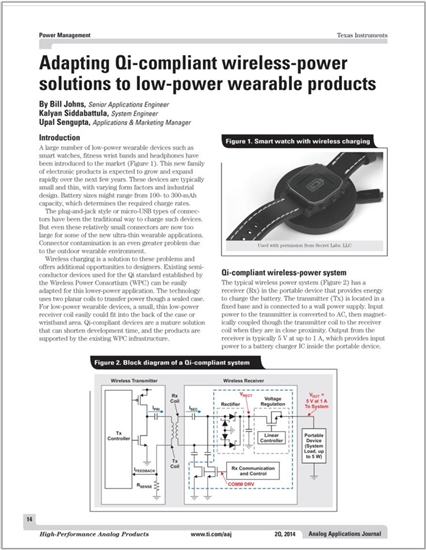Low-power wearable devices, such as smart watches, fitness wrist bands and headphones continue to hit the market, and their small designs require new challenges. These challenges range from bendable displays to bendable batteries, wireless connectivity and the biggest one of all - keeping the wearable device charged. Some makers use a "plug-and-jack" style or micro-USB connector, so consumers can plug the device in to charge it at the end of the day. So why is this a challenge? Small connectors are still too large for some of the new ultra-thin wearable applications, and many wearable devices, like watches, are used outside. Outside elements can contaminate the connector and reduce the life of the device. Wireless charging solves this dilemma, and gives wearable makers the opportunity to differentiate their products and offer exciting, innovative designs to consumers.
Click to download the brand new white paper to see how to easily add Qi-compliant wireless charging capability to your design. The paper is co-written by TI's leading experts on wireless power design, Bill Johns, Kalyan Siddabattula and Upal Sengupta.
The new paper, included in TI's Analog Application Journal, features the new 2.5-W bq51003 wireless power receiver that is specifically adapted for low-power applications. The receiver features Dynamic Rectifier Control to improve load transient behavior and Dynamic Efficiency Scaling to tailor the light-load voltage to maximum output load and achieve high efficiency - even at low output power range of 5 V at 100 mA to 250 mA..
A wearable device also needs to efficiently charge when connecting to a Qi-compliant charging pad or station connected to a USB port or small adapter. The bq500211 transmitter controller works well with low-power receiver ICs, like the bq51003, with low current demand.
What do you think wireless charging will mean for wearable designs? What exciting applications will we see in the future?
Additional Resources:
- Download the new white paper: "Adapting Qi-compliant wireless power solutions to low-power wearable products."
- Order samples and development kit for the bq51003 wireless power receiver.
- Download the data sheet for the bq500211 transmitter.
- Select the right wireless power IC for your design: Wireless power solutions.
- Check out other articles and subscribe to the TI Analog Application Journal.

